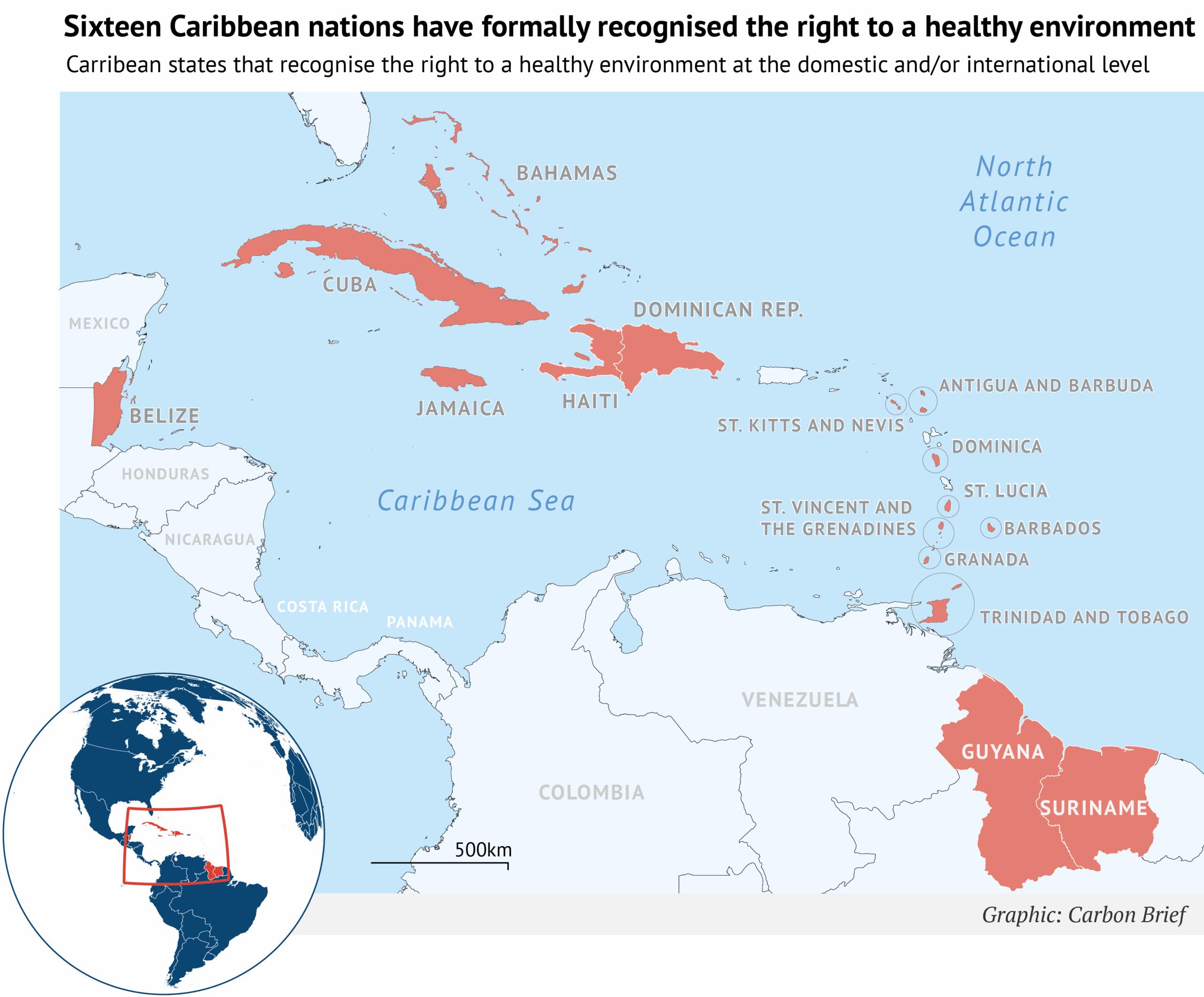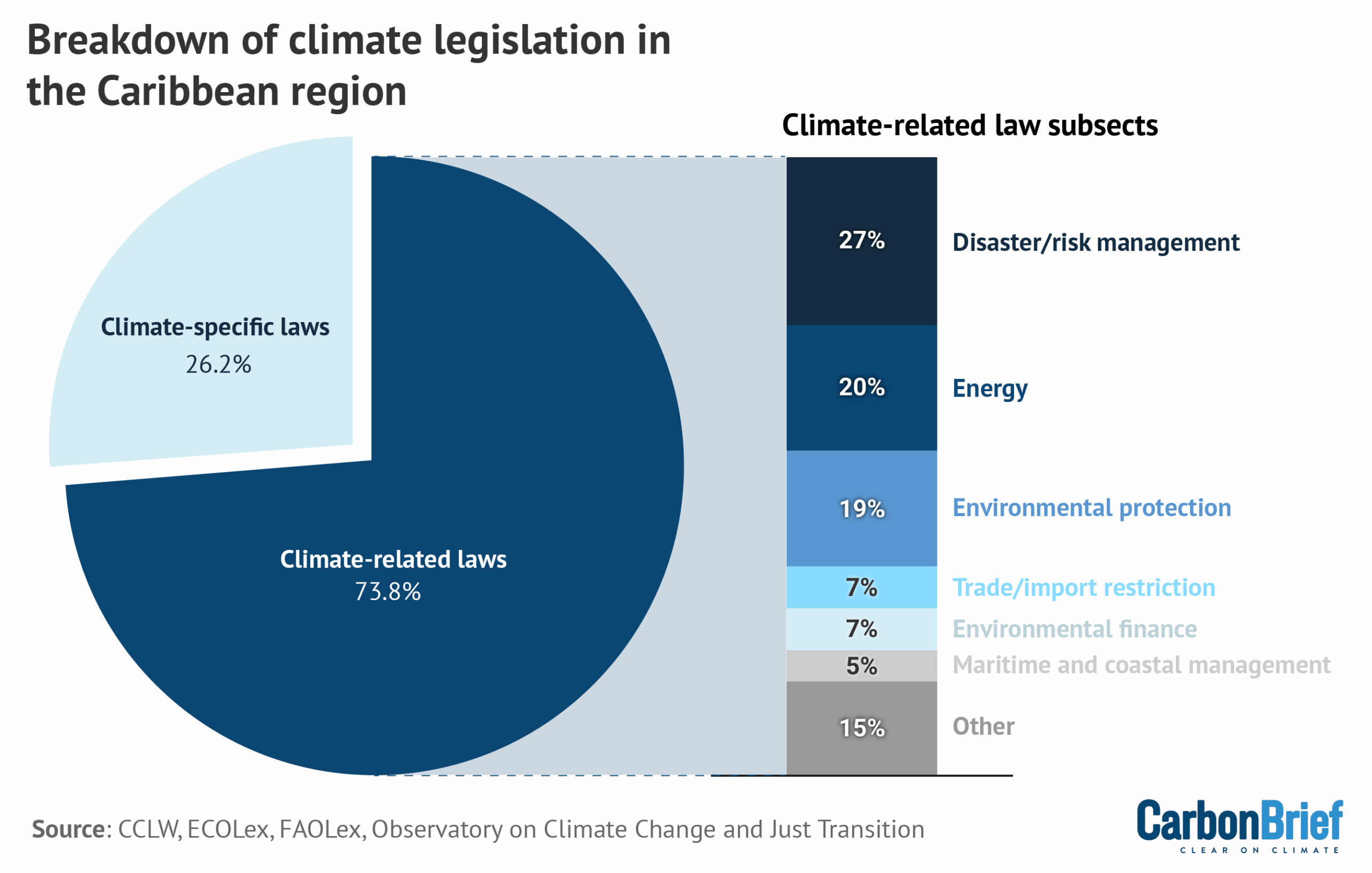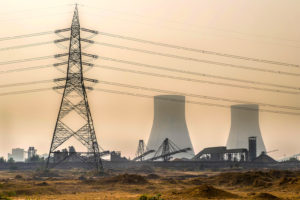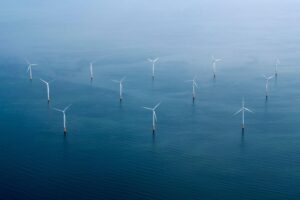The EU’s carbon border adjustment mechanism (CBAM) has been touted as a key policy for cutting emissions from heavy industries, such as steel and cement production.
By taxing carbon-intensive imports, the EU says it will help its domestic companies take ambitious climate action while still remaining competitive with firms in nations where environmental laws are less strict.
There is evidence that the CBAM is also driving other governments to launch tougher carbon-pricing policies of their own, to avoid paying border taxes to the EU.
It has also helped to shift climate and trade up the international climate agenda, potentially contributing to a broader increase in ambition.
However, at a time of growing protectionism and economic rivalry between major powers, the new levy has proved controversial.
Many developing countries have branded CBAMs as “unfair” policies that will leave them worse off financially, saying they will make it harder for them to decarbonise their economies.
Analysis also suggests that the EU’s CBAM, in isolation, will have a limited impact on global emissions.
In this Q&A, Carbon Brief explains how the CBAM works and the impact on climate policies it is already having in the EU and around the world, as nations such as the UK and the US consider implementing CBAMs and related policies of their own.
- What is a carbon border adjustment mechanism?
- Why was the CBAM introduced in the EU?
- How will the EU’s CBAM work?
- How is the mechanism expected to cut emissions?
- What are the reactions from developing countries?
- Are other countries introducing their own mechanisms?
What is a carbon border adjustment mechanism?
A carbon border adjustment mechanism (CBAM) is a tax applied to certain imported goods, based on the amount of carbon dioxide (CO2) emissions released during their production.
It targets industries that are typically emissions-intensive and relatively easy to trade internationally, such as steel, aluminium and cement.
CBAMs work on the basis that climate laws and standards in some nations – usually those in the global north – are tighter than those found elsewhere.
This means that the producer of a particular emissions-intensive product might have to pay a domestic carbon price, for example, whereas an overseas competitor might not.
Under a CBAM, a nation that applies a carbon price to its domestic steel industry would apply an equivalent charge at the border, to steel imported from overseas.
This is meant to “level the playing field” between producers in different countries. Those that make goods at a lower cost, but without a domestic carbon price of their own, would have to pay an equivalent fee when exporting to the country imposing a CBAM. This would allow domestic industries in the importing country to compete, while still curbing their own emissions.
CBAMs have been proposed as a response to fears of “carbon leakage”.
If nations lose carbon-intensive businesses because they close down or choose to do business elsewhere, this could harm the economies of nations trying to implement carbon pricing. At the same time, it could increase global emissions, if domestic manufacturing is simply replaced by more carbon-intensive imports.
This issue has risen to prominence in recent years, as the EU has become the first actor to introduce a CBAM.
CBAMs have been discussed ever since the early days of international climate action in the 1990s. There was recognition at that time of the risks of carbon leakage, as developed countries were being tasked with cutting their emissions under the Kyoto Protocol.
In particular, the EU launching its emissions trading system (ETS) in 2005 prompted what one study describes as “heated discussion” of the role that border taxes could play in preventing high-emitting industries moving away from EU member states to other countries.
(Despite these concerns, there has to date been essentially no evidence of carbon leakage. However, researchers have noted that this could be because high-emitting industries are yet to face strict carbon pricing: those in the EU generally receive free emissions allowances.)
The EU frames its CBAM as not only a means of placing a “fair price” on emissions bound up in imported goods, but also a way to “encourage cleaner industrial production” in the nations it imports goods from.
However, critics say variously that it is more to do with economic protectionism, or that it will harm trade, or that it will exacerbate existing inequalities between nations.
Why was the CBAM introduced in the EU?
The EU CBAM was brought in as part of the European Green Deal, the EU’s strategy to reach net-zero emissions by 2050.
A CBAM has been under consideration in the EU for years. The European Commission informally proposed a border adjustment in 2007, following the launch of the ETS. In the years that followed, France suggested such a scheme on two more separate occasions.
In her 2019 manifesto to become European Commission president, Ursula von der Leyen raised the issue again, saying she would “introduce a carbon border tax to avoid carbon leakage” to “ensure our companies can compete on a level playing field”.
In recent years, there has been much concern around how the EU can avert “deindustrialisation” and maintain its competitive edge against other major powers, such as the US and China. The CBAM is one of the measures launched under Von der Leyen’s leadership in an effort to tackle these threats, whether perceived or real.
The idea came to fruition in 2021, when it was presented by the commission as part of its “Fit for 55” package to drive the EU’s transition to net-zero. Following negotiations with EU member state governments and members of the European Parliament, the CBAM became law in May 2023.
One reason the CBAM was finally adopted in the EU was because of a perceived need to avoid carbon leakage, while also ramping up overall emissions reductions. Emissions from heavy industry in the EU have not fallen considerably since 1990, despite being covered by the EU ETS for two decades.
This is partly because these sectors, many of which are considered “exposed” to international trade – and, therefore, carbon leakage – are handed free allowances in the EU ETS. These allowances enable businesses to continue emitting greenhouse gases at no extra cost – or even to profit from selling free allowances, if their own production falls.
Companies in these sectors are, therefore, able to compete with foreign imports from countries that do not have carbon-pricing systems. However, the free allowances also mean those companies have less of a financial incentive to decarbonise.
The CBAM is explicitly described as a replacement for the free allowances given to companies making steel, cement and other trade-exposed goods. It will be phased in as those allowances are phased out, a process that will be complete in 2034.
The CBAM has been framed as an “enabling policy” that boosts the political acceptability of higher carbon prices within the EU and, in doing so, drives industrial decarbonisation.
However, it has also been described as a policy to encourage global emissions cuts. After Von der Leyen took over as commission president, a communication concerning the European Green Deal said the CBAM would be introduced “should differences in levels of ambition worldwide persist, as the EU increases its climate ambition”.
Finally, another reason for the measure is that the European Commission estimates it will raise €1.5bn in revenue in 2028 – and this will increase as the mechanism expands. Of this total, 75% will go to the EU budget and the rest to member states.
How will the EU’s CBAM work?
The EU CBAM is being rolled out gradually. Between October 2023 and the end of 2025, any company that imports goods covered by the CBAM into the EU will have to declare them in quarterly reports.
The products covered by the CBAM include those deemed “at most significant risk of carbon leakage” by the EU, initially including cement, iron, steel, aluminium, fertilisers and hydrogen, as well as electricity transmitted from other countries.
This list is expected to expand, following further assessments by the EU, to cover sectors such as ceramics and paper.
Reporting will cover all of the emissions generated when those products are made. This includes “direct” emissions, such as the carbon dioxide (CO2) released during cement production, and “indirect” emissions, such as those from the fossil-fuel generated electricity used to power cement factories.
The full compliance phase of the CBAM will begin from the start of 2026. From this point, companies bringing CBAM-covered goods into the EU will have to purchase enough CBAM certificates to cover their associated emissions. The cost of these certificates will be the same as the EU ETS market price.
If companies can demonstrate that they have paid a carbon price for goods in their country of origin, they will be able to deduct a corresponding amount from their certificate purchases to avoid taxing the products twice.
Initially, exporters in relevant sectors will only have to buy certificates equivalent to 2.5% of the emissions associated with producing their goods. This obligation will rise to 100% by 2034, in line with the removal of free allowances for EU industries.
The EU says that, when “fully phased in”, the CBAM will apply to more than half of the emissions covered by the ETS overall.
How is the mechanism expected to cut emissions?
The CBAM will add a carbon cost to EU imports that could encourage emissions cuts both domestically and internationally.
The mechanism is supposed to drive industrial decarbonisation by facilitating the removal of free EU ETS allowances for industries such as steel and cement.
Maintaining domestic industries in the EU is also intended to avoid an increase in global emissions due to carbon leakage.
Yet various calculations of the overall impact of the EU CBAM on global emissions have produced fairly modest results.
An initial 2021 assessment by the European Commission estimated that its proposed CBAM design would reduce emissions from affected EU industries by 1% by 2030. It calculated that global emissions from these industries would be cut by 0.4% over the same timescale.
More recent analysis, conducted by the Asian Development Bank (ADB), considers the impact of the CBAM at a carbon price of €100 per tonne of CO2 – a level that was reached for the first time last year before falling again.
It concludes that the CBAM would reduce global emissions by less than 0.2%, relative to the ETS on its own. This would be accompanied by a 0.4% drop in global exports to the EU.
Ian Mitchell, a senior policy fellow and co-director of the Europe programme at the Center for Global Development (CGD), tells Carbon Brief:
“It’s not so surprising that CBAM has a modest impact on global emissions. As a unilateral measure, most of the trade in carbon it affects will be diverted to other jurisdictions without similar charges.”
However, he adds that CBAM is still “extremely important and valuable”, because it establishes the principle of carbon pricing and a “level playing field” globally.
Another key way that the CBAM could drive emissions cuts is by encouraging other nations to implement their own climate measures, including carbon pricing.
A recent report by the NGO Resources for the Future says the hope is that CBAMs will “lead to a virtuous cycle, where more and more countries adopt carbon pricing”. It explains that CBAMs can allow governments to overcome domestic political constraints to carbon pricing:
“The external pressure of a CBAM can provide both impetus and a scapegoat, akin to pushing an open door, as policymakers can point out that exporting firms would have to pay these fees when they export regardless of domestic policy action.”
The EU CBAM has already sparked a wave of responses from other countries. These have ranged from threats of retaliatory measures (see: What are the reactions from developing countries?) to plans for domestic CBAMs of their own (see: Are other countries introducing their own mechanisms?).
Yet there is some debate about how much the EU’s policy is spurring on climate action.
Analysis by CGD at the end of 2023 concluded that the “vast majority of lower income countries are a long way from implementing any carbon price”. At that time, no low-income countries were considering carbon pricing and only 11% of lower-middle income countries had one “scheduled or under consideration”, the group concluded.
Others assessments have been more optimistic. One early report from thinktank Clingendael linked new climate policies from nations including Turkey and Russia to the looming threat of CBAM.
A more recent report for the International Emissions Trading Association (IETA), which speaks for companies involved in global carbon markets, tracks responses from countries trading with the EU.
Julia Michalak, EU policy head at IETA, tells Carbon Brief that, ultimately, the CBAM is “not in itself a global mitigation policy tool”. However, she points to evidence of impacts, including Turkey, India and Brazil advancing work on their own ETSs, as well as China moving to expand its ETS to include cement, steel and aluminium – mirroring the EU CBAM.
Critical experts from global-south institutions have argued that sharing emissions-cutting technologies and scaling up climate finance would be more effective measures to decarbonise industries in developing countries.
(The EU CBAM text includes language about supporting “efforts towards the decarbonisation and transformation of…manufacturing industries” in developing countries.)
There has been discussion around using CBAM revenues to support industrial decarbonisation in other countries, although there has so far been no formal agreement to do this.
A report by the Centre for Science and Environment (CSE) argues that CBAM revenues could be a new form of climate finance for developing countries. The thinktank suggests that this could function in a similar way to the EU’s modernisation fund, which is financed with ETS revenue and supports clean energy in low-income EU states.
What are the reactions from developing countries?
Some of the most vocal opponents of the EU’s CBAM are among those expected to be most exposed to its impacts.
The map below is colour-coded according to nations’ relative exposure, according to the World Bank, based on the carbon intensity of their industries and how much they rely on exporting CBAM-covered products to the EU.
Nations shaded green could gain export competitiveness to the EU, while those shaded red could lose competitiveness.

Many of the most exposed nations have vocally opposed what they describe as “unilateral” trade measures, both at UN climate negotiations and at the World Trade Organization (WTO), where they have questioned their compatibility with international trade rules.
Some of them have argued that the costs of compliance will leave less money for dealing with poverty and meeting their Paris Agreement targets.
Observers have cited the principle of “common but differentiated responsibilities”, arguing that the EU is penalising developing countries despite its historic – and current – high levels of emissions, relative to much of the global south. Avantika Goswami, climate change programme lead at CSE, tells Carbon Brief:
“You are imposing these external standards onto developing countries whilst not specifically earmarking funding that would enable this decarbonisation effort.”
China is one of the developing countries affected by the CBAM that has criticised the EU’s new policy.
China’s steel and aluminium sector would see the biggest impacts, according to an analysis from the Center for Eco-Finance Studies at Renmin University. It estimated a 4-6% ($200m-400m) increase in export costs for the steel industry, for example.
(The analysis does not appear to account for potential price rises in EU steel markets, which could allow producers to recoup higher costs at the expense of consumers within the bloc.)
Li Chenggang, China’s ambassador to WTO, said at a meeting last June:
“We fully understand the EU’s environmental goals and appreciate its efforts…However, it is regrettable that the [CBAM] measures…fail to follow the basic principles of the UNFCCC and the Paris Agreement [the principle of “common but differentiated responsibilities”], as well as WTO rules. In fact, this measure may cause discrimination and market access restrictions on imported products, especially those from developing members.”
A report by the China office of consultancy PwC says about $35bn of trade between China and the EU could eventually be affected by the CBAM.
African countries have raised similar concerns. According to Akinwumi Adesina, president of African Development Bank, the continent could lose up to $25bn per year as a “direct result of CBAM”.
However, the $25bn figure cited by Adesina comes from a modelling scenario that does not correspond to the EU’s actual approach, says Tennant Reed, director of climate change and energy at the Australian Industry Group, in a post on LinkedIn.
In his post, Reed points to a series of issues with the underlying modelling in this and other studies of the impact of the EU’s CBAM on developing countries’ economies. He tells Carbon Brief:
“CBAM analysis can easily go awry if it: considers higher supply costs for covered products but not higher selling prices; assumes manufacturers and nations have static emissions intensities; or fails to represent the actual structure of policy. A genuinely non-discriminatory border adjustment should not disadvantage developing country exporters at all. Instead it can create a firmer commercial basis for clean industrial investment everywhere and a chance for developing countries that price carbon to effectively raise tax revenue from Europe.”
In July 2024, India’s economic affairs secretary Ajay Seth commented that the EU’s CBAM was “unfair and detrimental to domestic market costs”.
There have even been reports of India planning “retaliatory” trade measures and the Indian government has indicated its concerns will feed into discussions around India’s prospective free-trade agreement with the EU.
In addition, Simon Göss, managing director of the Berlin-based consulting firm carboneer, tells Carbon Brief that, for smaller companies, “hir[ing] [data] experts and set[ting] up monitoring systems…might make the end product more expensive”. He adds:
“In the short-term – until the end of 2024 – monitoring and reporting real emissions for producers of CBAM-goods in non-EU countries represents a huge challenge for smaller companies in technologically less advanced countries.”
Despite their criticisms, some developing country analyses have pointed to positive steps that their industries can take in response to the EU’s CBAM.
Beijing-based thinktank iGDP, for example, says, “looking at the long-term trend, China’s steel industry striv[ing] to reduce emissions is more economical than to pay the CBAM adjustment fee”.
Similarly, Renmin University says in a CBAM analysis that China’s steel industry should accelerate its shift to lower emissions and the country’s own carbon market “should be improved”.
Are other countries introducing their own mechanisms?
Other nations are expected to implement CBAMs and related measures of their own in response to the EU’s new policy.
Progress on this has been fairly slow, but there are signs that some nations in the global north are considering this approach in order to protect trade with the EU and support their own industrial decarbonisation.
Perhaps the most advanced CBAM outside of the EU is the UK’s effort. The UK government announced at the end of 2023 that it would implement the mechanism by 2027.
Unlike the EU’s CBAM, the UK’s version, in its initial stage, will include ceramics and glass. It will also not include the electricity the UK imports from its European neighbours via interconnectors. Some observers have called for greater harmonisation with the EU, suggesting that this would reduce the economic risk to the UK.
The Canadian government also announced plans to establish its own CBAM in the 2021 budget and launched a consultation to this effect.
Australia has also been considering a CBAM, with the government launching a review in 2023 to assess its potential to prevent carbon leakage – especially targeting steel and cement.
As for the US, there has been much debate around how it could implement a CBAM, despite lacking a domestic carbon-pricing system. (Carbon pricing has long proved controversial in the US. In fact an early form of CBAM was blocked in 2010 by Senate Republicans in the infamous Waxman-Markey bill, along with a national carbon pricing scheme.)
US leaders were initially hostile to the EU’s CBAM, even though the nation does not export large amounts of CBAM-covered products to the bloc. However, in the context of industrial rivalry with China, US lawmakers have proposed various CBAM-like policies in recent years, with a view to avoiding carbon leakage and ensuring global competitiveness.
These include the Clean Competition Act, backed by Democrats, and the Foreign Pollution Fee Act, backed by Republicans, both of which involve adding a carbon-intensity fee to imports.
Analysis by NGO Resources for the Future describes these proposals as a “significant sign of bipartisan interest in climate and trade policy”. Moreover, it says these actions can be attributed to the EU’s leadership in this area:
“Just as it is hard to imagine the EU coming up with as extensive a green industrial policy as it has without the [Inflation Reduction Act], it is equally hard to imagine the US devising specific climate and trade proposals without the impetus of CBAM.”
Ellie Belton, a senior policy advisor on trade and climate at the thinktank E3G, tells Carbon Brief that, while the EU CBAM “may well have kickstarted a new wave of climate ambition globally”, there is a need for “better diplomacy” to avoid disrupting multilateral progress:
“There is also an emerging risk of divergent CBAM schemes creating a patchwork of disjointed regulations worldwide, which would disproportionately impact developing countries and exacerbate the inequity in climate outcomes.”
Reflecting concerns about the impact such a “patchwork” could have on businesses, the International Chamber of Commerce has released a set of “global principles” to guide countries in introducing their own CBAMs.
Among other things, they include compliance with WTO rules and the principles of the Paris Agreement, as well as exemptions for least developed countries and small island states.
The post Q&A: Can ‘carbon border adjustment mechanisms’ help tackle climate change? appeared first on Carbon Brief.
Q&A: Can ‘carbon border adjustment mechanisms’ help tackle climate change?
Greenhouse Gases
DeBriefed 10 October 2025: Renewables power past coal; Legacy of UK’s Climate Change Act; Fukushima’s solar future
Welcome to Carbon Brief’s DeBriefed.
An essential guide to the week’s key developments relating to climate change.
This week
Renewables overtake coal
‘HISTORIC FIRST’: Renewables have overtaken coal to become the world’s leading source of electricity for the first six months of this year in a “historic first”, BBC News said. The analysis, from the thinktank Ember, found the world generated “almost a third” more solar power in the first half of the year, compared with the same period in 2024, while wind power grew by “just over 7%,” reported the Guardian.
HEAVY LIFTING: According to the report, China and India were “largely responsible for the surge in renewables”, while the US and Europe “relied more heavily on fossil fuels,” the Guardian wrote. China built more renewables than every other country combined in the first half of this year, the newspaper added.
CONTINENTAL SHIFTS: A second report from the International Energy Agency (IEA) predicted a “surge” in global wind and solar capacity by 2030, but shaved 5% off its previous forecast, the Financial Times said. The IEA revealed that India is set to become the second-largest growth market for renewables after China, “with capacity expected to increase 2.5 times by 2030”, Down to Earth reported. The IEA also upped its forecast for renewables in the Middle East and north Africa by 23%, “helped by Saudi Arabia rolling out wind turbines and solar panels”, but halved the outlook for the US, the FT noted.
Around the world
- EV BOOM: Sales of electric and hybrid cars made up “more than half” of all new car registrations in the UK last month, a new record, according to data from the Society of Motor Manufacturers, reported BBC News.
- BANKING COLLAPSE: A global banking alliance launched by the UN to get banks to slash the carbon footprint of their loans and investments and help drive the transition to a net-zero economy by 2050 has collapsed after four years, Agence France-Press reported.
- CUTS, CUTS, CUTS: The Trump administration plans to cut nearly $24bn in funding for more than 600 climate projects across the US, according to documents reviewed by the Wall Street Journal.
- PEOPLE POWER: A farmer, a prison guard and a teacher were among those from the Dutch-Caribbean island Bonaire who appeared at the Hague on Tuesday to “accuse the Netherlands of not doing enough to protect them from the effects of climate change”, Politico reported.
400,000
The number of annual service days logged by the US National Guard responding to hurricanes, wildfires and other natural disasters over the past decade, according to a Pentagon report to Congress, Inside Climate News reported.
Latest climate research
- Politicians in the UK “overwhelmingly overestimate the time period humanity has left to bend the temperature curve”, according to a survey of 100 MPs | Nature Communications Earth and Environment
- Fire-driven degradation of the Amazon last year released nearly 800m tonnes of CO2 equivalent, surpassing emissions from deforestation and marking the “worst Amazon forest disturbance in over two decades” | Biogeosciences
- Some 43% of the 200 most damaging wildfires recorded over 1980-2023 occurred in the last decade | Science
(For more, see Carbon Brief’s in-depth daily summaries of the top climate news stories on Monday, Tuesday, Wednesday, Thursday and Friday.)
Captured

The UK’s Climate Change Act, landmark legislation that guides the nation’s response to climate change, is increasingly coming under attack from anti-net-zero right-leaning politicians. In a factcheck published this week, Carbon Brief explained how the UK’s Climate Change Act was among the first comprehensive national climate laws in the world and the first to include legally binding emissions targets. In total, 69 countries have now passed “framework” climate laws similar to the UK’s Climate Change Act, with laws in New Zealand, Canada and Nigeria among those explicitly based on the UK model. This is up from just four when the act was legislated in 2008. Of these, 14 are explicitly titled the “Climate Change Act”.
Spotlight
Fukushima’s solar future
This week, Carbon Brief examines how Fukushima helped to recover from nuclear disaster by building solar farms on contaminated farmland.
On 11 March 2011, an earthquake off the pacific coast of Japan caused 15m-tall waves to crash into the eastern region of Tōhoku, killing 19,500 people and injuring a further 6,000.
In the aftermath, flooding at the Fukushima Daichi nuclear power plant caused cooling systems to fail, leaching radioactive contaminants into the soil and leading to a major nuclear incident.
Some 1,200km2 around the site was restricted and up to 100,000 people were evacuated – in some cases forever.
In the years following, Japan entered a fraught debate about nuclear energy.
In 2010, nuclear power provided 25% of Japan’s electricity, but, in the years following the disaster, its 54 nuclear reactors were taken offline.
Successive governments have fought over reintroducing nuclear power. Today, some 14 reactors are back online, 27 have been permanently closed and another 19 remain suspended. (Japan’s newly-elected prime minister Sanae Takaichi has promised to make nuclear central to her energy strategy.)
Against this backdrop, Fukushima – a prefecture home to 1.8 million people – has emerged as a surprise leader in the renewables race.
In 2014, the Fukushima Renewable Energy Institute (FREA) opened with the twin goals of promoting research and development into renewable energy, while “making a contribution to industrial clusters and reconstruction”.
That same year, the prefecture declared a target of 100% renewable power by 2040.
Contaminated land
“A lot of these communities, I know, were looking for ways to revitalise their economy,” said Dr Jennifer Sklarew, assistant professor of energy and sustainability at George Mason University and author of “Building Resilient Energy Systems: Lessons from Japan”.
Once evacuation orders were lifted, however, residents in many parts of Fukushima were faced with a dilemma, explained Skarlew:
“Since that area was largely agricultural, and the agriculture was facing challenges due to stigma, and also due to the soil being removed [as part of the decontamination efforts], they had to find something else.”
One solution came in the form of rent, paid to farmers by companies, to use their land as solar farms.
Michiyo Miyamoto, energy finance specialist at the Institute for Energy Economics and Financial Analysis, told Carbon Brief:
“The [Fukushima] prefecture mapped suitable sites early and conducted systematic consultations with residents and agricultural groups before projects were proposed. This upfront process reduced land-use conflicts, shortened permitting timelines and gave developers clarity.”
As a result, large-scale solar capacity in Fukushima increased to more than 1,300 megawatts (MW) from 2012 to 2023, according to Miyamoto. Moreover, installed renewable capacity now exceeds local demand, meaning the region can run entirely on clean power when conditions are favourable, Miyamoto said.
Today, aerial pictures of Fukushima reveal how solar panels have proliferated on farmland that was contaminated in the nuclear disaster.

Charging on
Last year, 60% of Fukushima’s electricity was met by renewables, up from 22% in 2011. (The country as a whole still lags behind at 27%.)
And that is set to grow after Japan’s largest onshore windfarm started operations earlier this year in Abukuma, Fukushima, with a capacity of 147MW.
The growth of solar and wind means that Fukushima is already “ahead of schedule” for its 2040 target of 100% renewable power, said Miyamoto:
“The result is a credible pathway from recovery to leadership, with policy, infrastructure and targets working in concert.”
Watch, read, listen
OVERSHOOT: The Strategic Climate Risks Initiative, in partnership with Planet B Productions, has released a four-part podcast series exploring what will happen if global warming exceeds 1.5C.
DRONE WARFARE: On Substack, veteran climate campaigner and author Bill McKibben considered the resilience of solar power amid modern warfare.
CLIMATE AND EMPIRE: For Black history month, the Energy Revolution podcast looked at how “race and the legacies of empire continue to impact the energy transition”.
Coming up
- 12 October: presidential elections, Cameroon
- 13-14 October: Pre-COP, Brasilia, Brazil
- 13-18 October: World Bank Group/IMF annual meetings, Washington DC
- 14-17 October: 2nd extraordinary session of the Marine Environment Protection Committee at the International Maritime Organisation, London
- 15-16 October: Circle of Finance Ministers report
Pick of the jobs
- Buckinghamshire Council, principal climate change officer | Salary: £49,354-£51,759. Location: Aylesbury, Buckinghamshire
- Sustainable NI, sustainable business lead | Salary: £60,000. Location: Belfast, Northern Ireland
- Dialogue Earth, South Asia managing editor | Salary: £1,875 per month. Location: South Asia
DeBriefed is edited by Daisy Dunne. Please send any tips or feedback to debriefed@carbonbrief.org.
This is an online version of Carbon Brief’s weekly DeBriefed email newsletter. Subscribe for free here.
The post DeBriefed 10 October 2025: Renewables power past coal; Legacy of UK’s Climate Change Act; Fukushima’s solar future appeared first on Carbon Brief.
Greenhouse Gases
Guest post: How Caribbean states are shifting climate legislation
The Caribbean region is among the most vulnerable to climate change, despite historically contributing less than half of one percent of global greenhouse gas emissions.
Rising sea levels, extreme heat and more frequent and intense storms – such as the 2024 Hurricane Beryl, which made landfall in Grenada – pose urgent and growing threats to the small island states, coastal nations and overseas territories that comprise the Caribbean region.
With global progress to address climate change still too slow, Caribbean countries are taking matters into their own hands by enacting more robust legislation to help protect against climate risks.
In a new study published in the Carbon and Climate Law Review, we identified 78 climate laws and legally binding decrees across 16 Caribbean states, as well as two constitutional references to climate change and a growing recognition of the right to a healthy environment.
Our analysis suggests that, together, these developments are not only enhancing resilience, but also positioning Caribbean states as influential actors in the global climate arena.
Caribbean climate laws on the rise
Climate governance in the Caribbean has expanded significantly in recent years. In the past decade, countries such as Cuba and the Dominican Republic have embedded climate obligations and programmatic guidelines into their national constitutions.
At the same time, legislative recognition of the human right to a healthy environment is gaining momentum across the region. Six Caribbean nations now affirm the right in their constitutions, while 15 have recognised it through international instruments, such as the UN Council, UN Assembly and the Escazu Agreement, as shown in the figure below.

More recently, there has been a notable rise in targeted, sector-specific climate frameworks that go beyond broader environmental statutes.
Saint Lucia stands out as the only country with a climate framework law, or a comprehensive national law that outlines long-term climate strategies across multiple domains. Meanwhile, several other Caribbean governments have adopted climate-specific laws that focus on individual sectors, such as energy, migration and disaster management.
According to our analysis, more than a quarter of climate-relevant legislation in the region – comprising 21 laws and legally binding decrees – now has an explicit focus on climate change, as illustrated in the chart below.
Our research suggests that this represents an ongoing shift in legislative focus, reflecting changes in how climate legislation is being structured in one of the world’s most climate-vulnerable regions.

Caribbean nations are also advancing legal reforms to structure and institutionalise climate finance and market mechanisms directly into domestic law, aligned with Article 6.2 of the Paris Agreement.
For example, the Bahamas has introduced provisions for carbon credit trading, while Antigua and Barbuda, Barbados and Grenada have established national climate financing mechanisms to support mitigation and adaptation efforts.
Some states, including Belize and Saint Kitts and Nevis, have incorporated regional bodies such as the Caribbean Community Climate Change Centre – the climate arm of the intergovernmental Caribbean community organisation CARICOM – into national frameworks. This indicates an increasing alignment between regional cooperation and domestic law.
In addition to the influx of regulations specifically addressing climate change, Caribbean nations are also legislating broader environmental issues, which, in turn, could provide increased resilience from climate impacts and risks, as shown in the graph above.
Key trends in these types of climate-related laws include the expansion of disaster risk management governance, which addresses national preparedness for climate-induced weather events or related catastrophes. Likewise, energy law is an increasingly prominent focus, with countries including Antigua and Barbuda and Saint Vincent and the Grenadines integrating renewable energy and energy efficiency goals into national climate governance.
More broadly, many Caribbean nations have adopted wide-ranging and comprehensive environmental laws, many of which were developed in alignment with existing climate commitments. In combination, these legal developments reflect a dynamic and evolving climate governance landscape across the region.
Proactive vs reactive approaches
Despite general alignment with these broader regional trends, our research reveals distinct developmental pathways shaping domestic climate regulation.
In the eastern Caribbean, for example, we saw both proactive, long-term planning strategies and reactive, post-disaster reforms.
Saint Lucia’s multifaceted approach to climate resilience evolved steadily over the course of more than a decade. During this time, the country developed numerous adaptation plans, strengthened cross-sectoral coordination and engaged in institutional climate reforms in areas such as energy, tourism, finance and development.
More recently, the passage of Saint Lucia’s Climate Change Act in 2024 marked a milestone in climate governance, by giving legal force to the country’s obligations under the UNFCCC, the Kyoto Protocol and the Paris Agreement – making Saint Lucia one of the few small island states to incorporate global climate commitments into domestic law.
Our research indicates that this strategy has not only positioned the country as a more climate-resilient nation, but also solidified its access to international climate financing.
In contrast, Dominica’s efforts evolved more rapidly in the aftermath of Hurricane Maria in 2017, which destroyed over 200% of the country’s GDP. The storm’s impacts were felt across the country and hit particularly hard for the Kalinago people – the Caribbean’s last Indigenous community – highlighting the role of socioeconomic disparities in shaping climate vulnerability and resilience.
In response, the government passed the Climate Resilience Act, creating the temporary Climate Resilience Execution Agency for Dominica (CREAD).
Beyond establishing an exclusively climate-focused institution, the act aimed to embed resilience into governance by mandating the participation of vulnerable communities – including Indigenous peoples, women, older people and people with disabilities – in shaping and monitoring climate resilience projects.

As noted in a recent statement by the UN special rapporteur on Climate Change, Dr Elisa Morgera, these frameworks underscore the government’s ambition to become the world’s first “climate-resilient nation.”
Although challenges persist, Dominica’s efforts demonstrate how post-disaster urgency can drive institutional change, including the integration of rights and resilience into climate governance.
Uneven progress and structural gaps
Despite significant progress, our research shows that several key opportunities for climate governance across the Caribbean continue to exist, which could enable improvements in both resilience and long-term ambition.
The region’s legal landscape remains somewhat heterogeneous. While Saint Lucia has enacted a comprehensive climate framework law, the rest of the region lacks similar blanket legislation. This includes some states that entirely lack climate-specific laws, instead relying on related laws and frameworks to regulate and respond to climate-related risks.
Other nations have yet to adopt explicit disaster-risk management frameworks, leaving Caribbean populations vulnerable before, during and after climate emergencies. Most have yet to enshrine the right to a healthy environment at the national level.
Our research suggests that outdated legal frameworks are further limiting progress in addressing current climate risks. Because many of the longer-standing environmental laws in the region were adopted well before climate policy became a mainstream concern, some fail to address the nature, frequency and intensity of modern climate challenges, such as sea-level rise, tropical storms, wildfires, floods, droughts and other impacts.
More broadly, many Caribbean climate laws include limited integration of gender equity, Indigenous rights and social justice. As Caribbean nations such as Grenada and the Dominican Republic begin to link climate resilience with these issues, the region has an opportunity to lead by example.
Ultimately, capacity and resource constraints persist as significant barriers to implementation and adaptation.
The Caribbean region faces debt that exacerbates ongoing development challenges, a burden made heavier by the repeated economic shocks of climate-related disasters. Along with regional debt-for-resilience schemes, increased funding from high-emitting countries to support adaptation measures in climate-vulnerable nations – as endorsed under the Paris Agreement – is likely to be critical to ensuring the region’s climate laws can be executed effectively.
Global implications of Caribbean climate law
Our research suggests that Caribbean countries are outpacing other regions in terms of the scope and ambition of their climate laws. This legislation has the potential to serve as a model for climate-vulnerable nations worldwide.
Continuing efforts in the region show that legal frameworks in the field can not only drive resilience, embed rights and strengthen claims to international finance, but also highlight how regional cooperation and diplomacy can enhance global influence.
These findings demonstrate that innovation in climate law need not wait for action from major emitters, but can instead be led by those on the front lines of climate change.
The post Guest post: How Caribbean states are shifting climate legislation appeared first on Carbon Brief.
Guest post: How Caribbean states are shifting climate legislation
Greenhouse Gases
IEA: Renewables have cut fossil-fuel imports for more than 100 countries
More than 100 countries have cut their dependence on fossil-fuel imports and saved hundreds of billions of dollars by continuing to invest in renewables, according to the International Energy Agency (IEA).
It says nations such as the UK, Germany and Chile have reduced their need for imported coal and gas by around a third since 2010, mainly by building wind and solar power.
Denmark has cut its reliance on fossil-fuel imports by nearly half over the same period.
Renewable expansion allowed these nations to collectively avoid importing 700m tonnes of coal and 400bn cubic metres of gas in 2023, equivalent to around 10% of global consumption.
In doing so, the fuel-importing countries saved more than $1.3tn between 2010 and 2023 that would otherwise have been spent on fossil fuels from overseas.
Reduced reliance
The IEA’s Renewables 2025 report quantifies the benefits of renewable-energy deployment for electricity systems in fossil fuel-importing nations.
It compares recent trends in renewable expansion to an alternative “low renewable-energy source” scenario, in which this growth did not take place.
In this counterfactual, fuel-importing countries stopped building wind, solar and other non-hydropower renewable-energy projects after 2010.
In reality, the world added around 2,500 gigawatts (GW) of such projects between 2010 and 2023, according to the IEA, more than the combined electricity generating capacity of the EU and US in 2023, from all sources. Roughly 80% of this new renewable capacity was built in nations that rely on coal and gas imports to generate electricity.
The chart below shows how 31 of these countries have substantially cut their dependence on imported fossil fuels over the 13-year period, as a result of expanding their wind, solar and other renewable energy supplies. All of these countries are net importers of coal and gas.

In total, the IEA identified 107 countries that had reduced their dependence on fossil fuel imports for electricity generation, to some extent due to the deployment of renewables other than hydropower.
Of these, 38 had cut their reliance on electricity from imported coal and gas by more than 10 percentage points and eight had seen that share drop by more than 30 percentage points.
Security and resilience
The IEA stresses that renewables “inherently strengthen energy supply security”, because they generate electricity domestically, while also “improving…economic resilience” in fossil-fuel importer countries.
This is particularly true for countries with low or dwindling domestic energy resources.
The agency cites the energy crisis exacerbated by Russia’s invasion of Ukraine, which exposed EU importers to spiralling fossil-fuel prices.
Bulgaria, Romania and Finland – which have historically depended on Russian gas for electricity generation – have all brought their import reliance close to zero in recent years by building renewables.
In the UK, where there has been mounting opposition to renewables from right-wing political parties, the IEA says reliance on electricity generated with imported fossil fuels has dropped from 45% to under 25% in a decade, thanks primarily to the growth of wind and solar power.
Without these technologies, the UK would now be needing to import fossil fuels to supply nearly 60% of its electricity, the IEA says.
Other major economies, notably China and the EU, would also have had to rely on a growing share of coal and gas from overseas, if they had not expanded renewables.
As well as increasing the need for fossil-fuel imports from other countries, switching renewables for fossil fuels would require significantly higher energy usage “due to [fossil fuels’] lower conversion efficiencies”, the IEA notes. Each gigawatt-hour (GWh) of renewable power produced has avoided the need for 2-3GWh of fossil fuels, it explains.
Finally, the IEA points out that spending on renewables rather than imported fossil fuels keeps more investment in domestic economies and supports local jobs.
The post IEA: Renewables have cut fossil-fuel imports for more than 100 countries appeared first on Carbon Brief.
IEA: Renewables have cut fossil-fuel imports for more than 100 countries
-
Climate Change2 years ago
Spanish-language misinformation on renewable energy spreads online, report shows
-
Climate Change2 months ago
Guest post: Why China is still building new coal – and when it might stop
-
Climate Change Videos2 years ago
The toxic gas flares fuelling Nigeria’s climate change – BBC News
-

 Greenhouse Gases1 year ago
Greenhouse Gases1 year ago嘉宾来稿:满足中国增长的用电需求 光伏加储能“比新建煤电更实惠”
-
Greenhouse Gases2 months ago
Guest post: Why China is still building new coal – and when it might stop
-

 Climate Change1 year ago
Climate Change1 year ago嘉宾来稿:满足中国增长的用电需求 光伏加储能“比新建煤电更实惠”
-

 Carbon Footprint2 years ago
Carbon Footprint2 years agoUS SEC’s Climate Disclosure Rules Spur Renewed Interest in Carbon Credits
-
Renewable Energy3 months ago
US Grid Strain, Possible Allete Sale















